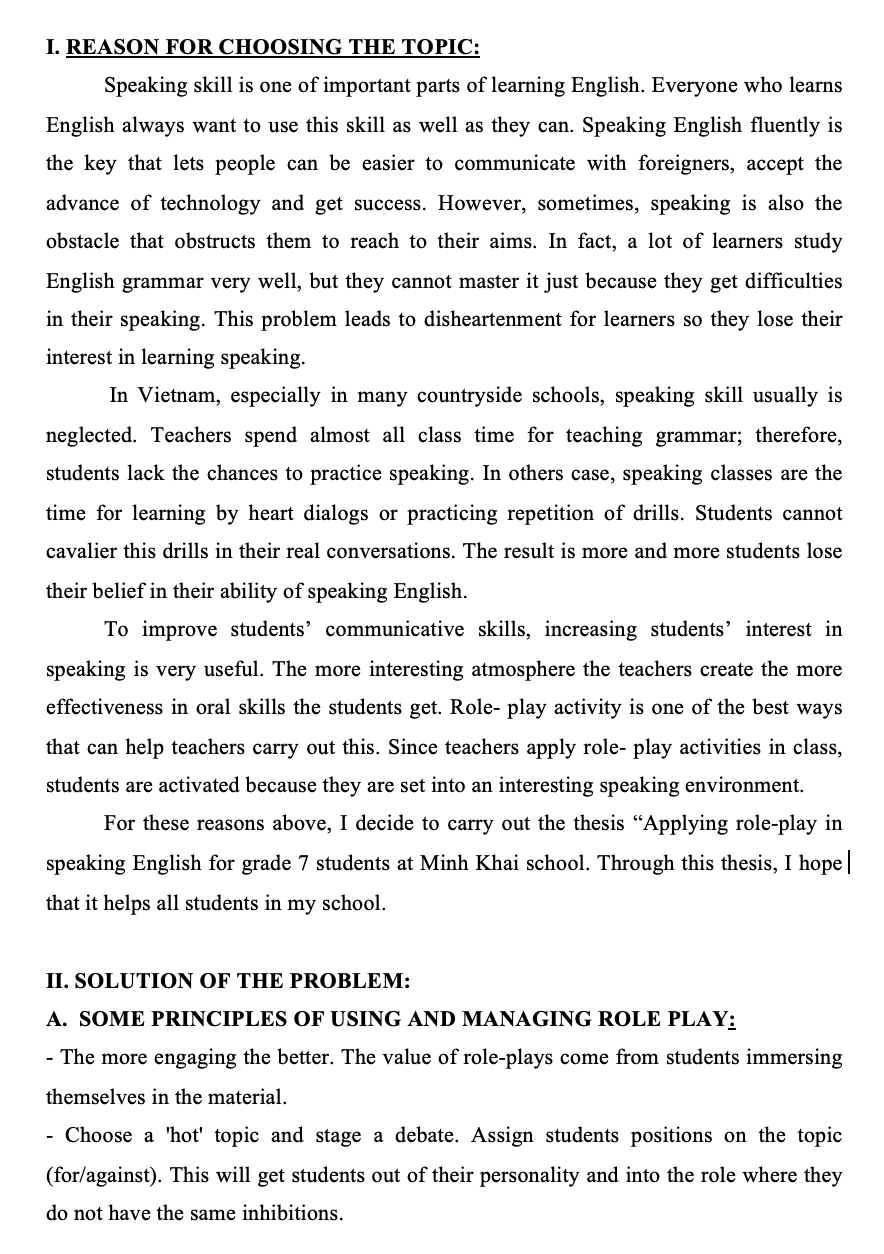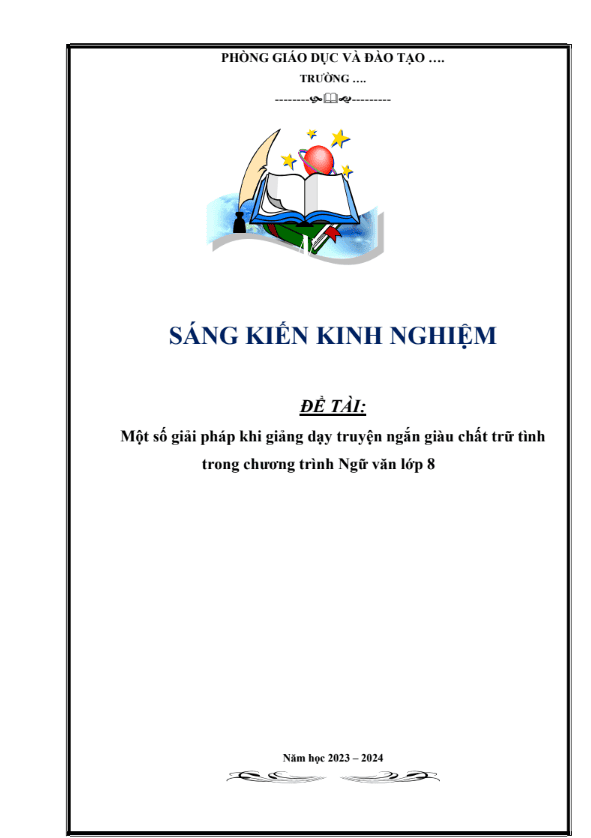SKKN Some experiences in using role- Plays in teaching speaking
- Mã tài liệu: BM7110 Copy
| Môn: | Tiếng anh |
| Lớp: | 7 |
| Bộ sách: | |
| Lượt xem: | 3178 |
| Lượt tải: | 4 |
| Số trang: | 39 |
| Tác giả: | Nguyễn Thị Thanh Tâm |
| Trình độ chuyên môn: | Cử nhân đại học |
| Đơn vị công tác: | Trường THCS Đoàn Kết |
| Năm viết: | 2021-2022 |
| Số trang: | 39 |
| Tác giả: | Nguyễn Thị Thanh Tâm |
| Trình độ chuyên môn: | Cử nhân đại học |
| Đơn vị công tác: | Trường THCS Đoàn Kết |
| Năm viết: | 2021-2022 |
Sáng kiến kinh nghiệm “SKKN Some experiences in using role- Plays in teaching speaking”:
– The more engaging the better. The value of role-plays come from students immersing themselves in the material.
– Choose a ‘hot’ topic and stage a debate. Assign students positions on the topic (for/against). This will get students out of their personality and into the role where they do not have the same inhibitions.
– Preparation is very important to success. Give students ‘personality cards’ which sketch out their personal characteristics or scenario. Divide students into groups and give them time to sketch out various scenarios, and go over extra or special vocabulary, ask them to discuss how they will act, think about the character and plan what they will say. For example, what are possible responses/replies for the angry neighbor ?
– The teacher, as facilitator of the role-play must support students in their role. they ‘are’ in the backyard arguing over the fence. Don’t do anything to interrupt the pretend environment. Leave grammar correction to the end. Correcting students in the middle of an argument interrupts the pretend environment. Make notes and do a debriefing after.
Mô tả sản phẩm
- REASON FOR CHOOSING THE TOPIC:
Speaking skill is one of important parts of learning English. Everyone who learns English always want to use this skill as well as they can. Speaking English fluently is the key that lets people can be easier to communicate with foreigners, accept the advance of technology and get success. However, sometimes, speaking is also the obstacle that obstructs them to reach to their aims. In fact, a lot of learners study English grammar very well, but they cannot master it just because they get difficulties in their speaking. This problem leads to disheartenment for learners so they lose their interest in learning speaking.
In Vietnam, especially in many countryside schools, speaking skill usually is neglected. Teachers spend almost all class time for teaching grammar; therefore, students lack the chances to practice speaking. In others case, speaking classes are the time for learning by heart dialogs or practicing repetition of drills. Students cannot cavalier this drills in their real conversations. The result is more and more students lose their belief in their ability of speaking English.
To improve students’ communicative skills, increasing students’ interest in speaking is very useful. The more interesting atmosphere the teachers create the more effectiveness in oral skills the students get. Role- play activity is one of the best ways that can help teachers carry out this. Since teachers apply role- play activities in class, students are activated because they are set into an interesting speaking environment.
For these reasons above, I decide to carry out the thesis “Applying role-play in speaking English for grade 7 students at Minh Khai school. Through this thesis, I hope that it helps all students in my school.
- SOLUTION OF THE PROBLEM:
- SOME PRINCIPLES OF USING AND MANAGING ROLE PLAY:
– The more engaging the better. The value of role-plays come from students immersing themselves in the material.
– Choose a ‘hot’ topic and stage a debate. Assign students positions on the topic (for/against). This will get students out of their personality and into the role where they do not have the same inhibitions.
– Preparation is very important to success. Give students ‘personality cards’ which sketch out their personal characteristics or scenario. Divide students into groups and give them time to sketch out various scenarios, and go over extra or special vocabulary, ask them to discuss how they will act, think about the character and plan what they will say. For example, what are possible responses/replies for the angry neighbor ?
– The teacher, as facilitator of the role-play must support students in their role. they ‘are’ in the backyard arguing over the fence. Don’t do anything to interrupt the pretend environment. Leave grammar correction to the end. Correcting students in the middle of an argument interrupts the pretend environment. Make notes and do a debriefing after.
– Exaggeration is good! Encourage students to exaggerate their actions, opinions and movements. Exaggeration helps students immerse themselves in the role.
– Stage a rehearsal first. Have students practice their role in small groups with coaching from the other students.
– While the role-play or debate is in progress, have other students suggest vocabulary first, and act as backup if they do not know.
– Role-plays are unpredictable which makes them both a valuable learning tool and at the same time difficult to manage. Sketch out the various routes the role-play can take from the initial scenario. This will give you some idea what to expect and avoid any surprises.
– Role-plays can range from 30 minutes to one hour.
- STEPS IN CARRING OUT ROLE- PLAYS:
- Outside the classroom:
_ Choosing the topic, based on the topic of the lesson or the main grammar point of that lesson.
_ Preparing materials, especially role-play cards (Teachers can make up the cards themselves, or search for them on the Internet)
- Inside the classroom:
_ Providing students with enough language to be used in their role-plays.
_ Setting up the scene for role-plays.
- SAMPLE LESSON PLANS:
Friendship
Version 1
Finding a Perfect Roommate/Flatmate Role-play
- Materials:
- Ranking Roommates: Vocabulary Warm-up
- Room Ads: Listening Reading Comprehension Warm-up
- Rooms for Rent Role Cards
- Friends Looking for Rooms Role Cards
- Students with Rooms for Rent Activity Sheet
- Students with Friends Needing Rooms Activity Sheet
- Purpose and Audience:
The purpose of these materials is to get the students to practice talking about the qualities of good and bad roommates.
- Target Language:
Describing people and their habits.
- Warm up:
- a) Group Discussion
- Where do you live?
- Do you live in a dormitory or with your family?
- Do you live with your family?
. + Who do you like best?
- What do you think about parents?
- What are the pros and cons of shared accommodation?
- 2 groups divided into Pros and Cons, then pair up Pro and Con to discuss
- c) Which would you choose?
In groups of 3, put Shared Accommodation Ads in pile face down. Students turn 1 up and explain to the group.
This accommodation is in (area).
It’s a (flat/house/townhouse)
There are (number) people living there.
It costs $____ a week.(other information)
Would you like to live there? Why or why not? – Discuss
After going through all six ads, choose the best one for you and explain why.
The Perfect Flatmate
What kind of person is good to live with? Why?
Ranking Exercise:
In groups, students circle the ideal qualities of roommates using the Ranking Exercise Vocabulary Sheet and then rank them in order of importance.
- Role-play
Set-up:
The class is divided into two groups:
Group 1: These students have a room for rent at their house because a roommate has just moved out. They will need a Room for Rent Role Card and a Room for Rent Activity Sheet.
Group 2: These students have a friend who is looking for a place to live. They will need a Friends Looking for a Place to Live Role Card and a Students with Friends Needing a Room Activity Sheet.
The students should be given some time to read their role cards, ask questions about vocabulary and then write down the concerns (from the role cards) into the table headings (on the activity sheets).
Divide the class chairs into two lines facing each other (or if you like, have an inner circle and outer circle). One line is for students with rooms to rent (Group 1)and the other line is for students who have friends who need a place to live (Group 2).
Group 1 students approach group 2 students and ask them if the group 2 students know anybody who needs a place to live. Group 2 students tell them they have a friend who is looking for a place. Group 2 will then ask questions to make sure that their friend will
TÀI LIỆU LIÊN QUAN
- 0
- 114
- 1
- [product_views]
- 2
- 163
- 2
- [product_views]
- 3
- 183
- 3
- [product_views]
- 0
- 124
- 4
- [product_views]
- 0
- 134
- 5
- [product_views]
- 0
- 109
- 6
- [product_views]
- 5
- 101
- 7
- [product_views]
- 7
- 117
- 8
- [product_views]
- 1
- 174
- 9
- [product_views]
- 8
- 179
- 10
- [product_views]
















